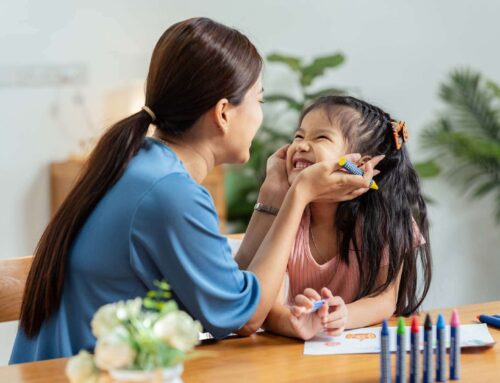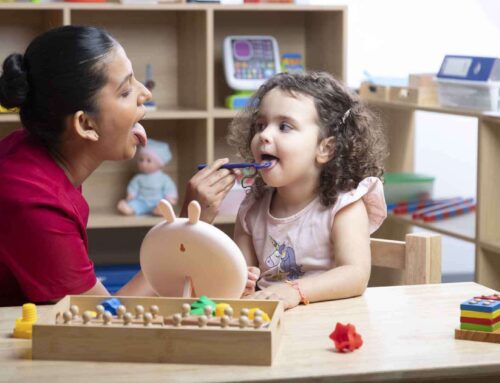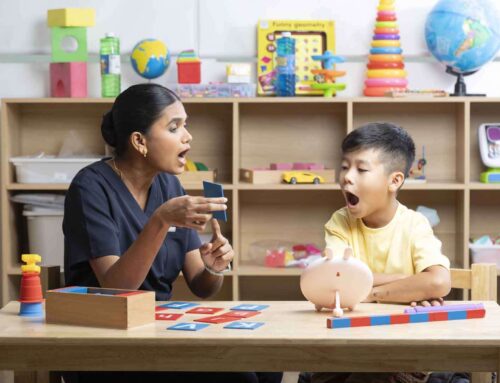At OrbRom Center in Phnom Penh, we believe that communication is more than words — it’s a full-body experience. Multisensory speech therapy uses sound, touch, and visuals to engage children’s senses and enhance learning. For many children in Cambodia, especially those with speech delays, autism, or other developmental challenges, a multisensory approach helps build stronger neural connections and makes therapy more meaningful and fun.
What Is Multisensory Speech Therapy?
Multisensory speech therapy involves activating multiple senses — hearing, sight, and touch — to improve speech, language, and communication skills. Instead of focusing only on listening or speaking, therapists at OrbRom Center design activities that help children see, feel, and hear language in action.
For example, when a child practices saying the “p” sound, they might:
-
Listen to the therapist model the sound.
-
Watch the therapist’s lips and a mirror reflection of their own mouth.
-
Feel the air puff on their hand as they pronounce it.
This layered learning helps reinforce motor patterns and builds awareness of how speech sounds are produced.
Why a Multisensory Approach Works
Children process information differently. Some respond best to visual cues, others to tactile input, and many benefit from a combination. Multisensory speech therapy allows therapists to adapt to each child’s strengths and sensory preferences.
Here’s why this approach is effective:
-
Engages multiple brain areas: When children see, hear, and feel speech cues, the brain creates stronger neural links.
-
Improves memory and recall: Sensory experiences make lessons more memorable.
-
Reduces frustration: Physical and visual supports help children understand abstract language concepts.
-
Encourages active participation: Hands-on, playful methods keep children motivated and involved.
For many young learners in Cambodia, especially in early childhood and preschool programs, multisensory strategies can make language development more natural and enjoyable.
Combining Sound, Touch, and Visuals in Therapy
At OrbRom Center, our speech therapists integrate multiple sensory elements into each session.
1. Sound: Building Auditory Awareness
Children are encouraged to listen carefully to speech sounds, rhythms, and intonations. Using songs, rhymes, and repetition, therapists strengthen listening and sound discrimination skills. Interactive activities like “sound hunts” or musical speech games help children connect sound to meaning — a key step in expressive language development.
2. Touch: Feeling the Words
Tactile learning helps children become aware of how their mouths, lips, and tongues move to create speech. Tools such as vibration pens, textured toys, and airflow activities are used to help children physically feel speech patterns. For children with apraxia of speech or articulation difficulties, this tactile feedback is especially beneficial.
3. Visuals: Seeing the Language Come Alive
Visual cues like picture cards, mirror exercises, gestures, and apps help children connect spoken words to images. Visual supports are particularly powerful for children with autism or language delays, as they make abstract ideas concrete. OrbRom therapists also use storyboards and interactive visuals to encourage sentence formation and storytelling.
When all three senses work together — hearing, seeing, and feeling — children gain a deeper understanding of communication and can generalize skills to real-world situations like school, home, and play.
Benefits for Cambodian Learners
In Cambodia, many children face barriers such as limited access to specialized education or delayed intervention. Multisensory speech therapy helps bridge these gaps by creating engaging, individualized learning opportunities.
At OrbRom Center in Phnom Penh, we’ve seen children who struggled to form sounds begin to speak clearly after integrating tactile and visual cues. Teachers and parents also notice improved focus, confidence, and social participation. The method aligns with Cambodia’s growing emphasis on inclusive education, ensuring that every child — regardless of ability — has the chance to communicate effectively.
Integrating Multisensory Learning at Home
Parents play a vital role in reinforcing therapy goals at home. Simple daily activities can make a big difference:
-
Sing and clap to the rhythm of songs together.
-
Use mirrors to practice speech sounds or facial expressions.
-
Play “I spy” games using pictures or household objects.
-
Encourage your child to trace letters or shapes while saying the sounds aloud.
These fun, multisensory moments turn learning into connection — something OrbRom Center encourages in every family.
How OrbRom Center Supports Multisensory Speech Development
OrbRom Center’s team of experienced speech-language pathologists and occupational therapists work together to create integrated, sensory-based intervention plans. Our programs are personalized to each child’s developmental profile and may include:
-
Speech Therapy for articulation, fluency, and language development.
-
Occupational Therapy to support sensory processing and motor coordination.
-
Assessments to identify strengths, challenges, and areas of need.
-
Special Needs Intensive Intervention for children requiring targeted one-on-one support.
-
Preschool Programs that integrate sensory learning into early education.
By combining expertise and compassion, OrbRom Center continues to set the standard for evidence-based, multisensory speech therapy in Phnom Penh.
Conclusion
Multisensory speech therapy is transforming how children in Cambodia experience communication. By combining sound, touch, and visuals, OrbRom Center helps children not only learn to speak — but to connect, express, and thrive. For families seeking effective and engaging speech therapy in Phnom Penh, our multisensory approach ensures every child’s voice is heard and celebrated.
We are the only Preschool specialized on children with special needs in PhnomPenh.
- Internationally qualified teachers
- Cambodia’s largest sensory room
- Outdoor swimming pool
- Covered outdoor playground
📞 Phone: 077.455.993
Telegram Link: https://t.me/OrbRom






Leave A Comment